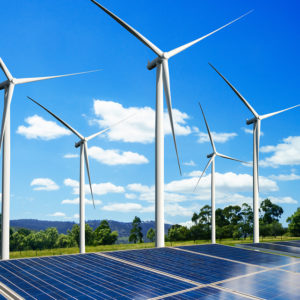With the stock market tanking and oil prices at a 10-year low — thanks to the coronavirus and the Saudi-Russian price war — here’s some good news. At the end of 2019, oil production in Texas was running at 5.3 million barrels per day, an all-time high and five times larger than output a decade earlier.
The “shale revolution” has made America the world’s No. 1 oil producer and insulated us from the periodic eruptions in the Middle East that threatened America’s energy security for decades. What’s more, the United States is now a net exporter of both oil and natural gas, which has helped reduce our trade deficit while supporting thousands of domestic jobs in the energy sector.
Surprisingly, even as we’ve become globally dominant in fossil fuels, we’ve also been investing heavily in “green energy,” especially wind and solar power. Last year alone, nearly $56 billion was invested in renewable energy in the United States, about 20 percent of the global total. Cumulative investment in American wind and solar projects now totals $269 billion. No other country comes close.
Another surprise is that Texas, by far the largest oil and gas producing state, is also the leader in renewable energy.
For years, it has led the nation with the most energy generated by wind power. Indeed, wind generators now account for more than 25 percent of the 80 gigawatts of installed power on the Electric Reliability Council of Texas (ERCOT) grid. (One gigawatt can power 700,000 homes.) At present, solar provides just 2.2 percent of energy to the grid. But solar developers are expected to add 9 gigawatts of capacity to the grid over the next two years.
Both renewables and natural gas are hastening the demise of coal for power generation in Texas and across the country. In 2001, 36 percent of the electrons on the ERCOT grid were produced in a coal plant; today coal’s percentage is 21 percent, meaning Texas now gets more of its electricity from wind than from coal. About 300 coal plants have been shuttered nationwide over the past decade. By 2030, coal may completely disappear as a power generation source.
This is good news for the environment, as the retirement of coal plants means cleaner air and lower greenhouse gas emissions. It’s also good news for Texas and America’s natural gas producers. Natural gas has been the predominant power-generation fuel for more than a decade, currently accounting for about half of Texas’ installed capacity.
Because Texas is the nation’s fastest-growing large state, power demand will continue to increase in the years ahead. And all of this new demand will be met by new wind and solar investments as well as baseload and “peaker” gas plants that can maintain grid reliability when the wind’s not blowing and the sun’s not shining.
In Texas, and elsewhere, renewables and natural gas have become partners, not competitors, in pursuing the goals of cutting emissions while ensuring an affordable and stable power supply.
That’s because natural gas makes it easier for intermittent solar and wind energy to penetrate electricity markets by providing the rapid backup required for grid stability. Conversely, without natural gas the widespread adoption of renewables would be slower, more complex and more expensive.
Big Oil is also getting into the renewable space. Exxon and Chevron are purchasing wind and solar power from West Texas and using that electricity to support their operations in the Permian Basin. Shell, BP and other majors have made huge commitments to invest in renewable energy in the years ahead, with some of that investment occurring in Texas.
The growth of renewables has also been a boon to the economy. According to the International Renewable Energy Agency, 855,000 American jobs are supported by wind, solar and other renewable technologies. In Texas alone, there are more than 233,000 workers in solar, wind and energy efficiency jobs.
As in the past, Texas is leading the nation through a dramatic energy transformation.
We are demonstrating to the rest of the country, and maybe the planet, that natural gas is not just a “bridge fuel” but a complementary energy source that can sustain the growing penetration of wind, solar and other renewable technologies for the foreseeable future.

